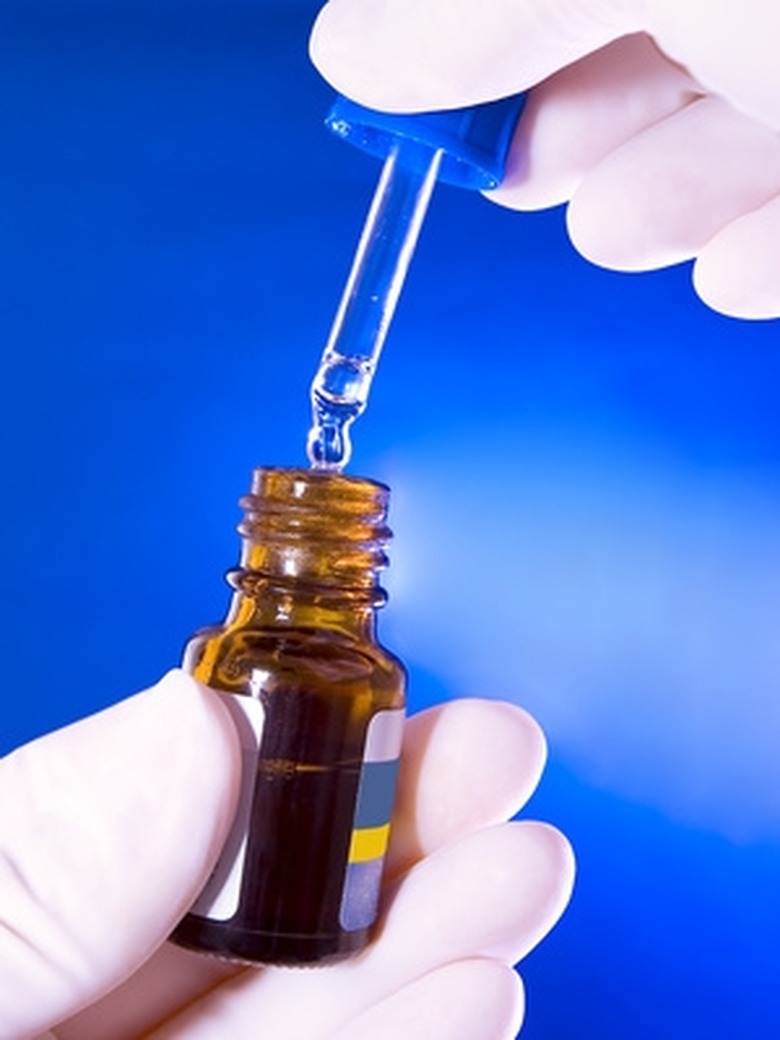How To Test For Potassium Iodide
Scientists refer to chemical tests that confirm the presence or absence of particular chemical species as "qualitative analysis." Such tests form the basis of a number of undergraduate laboratory experiments. No test exists for potassium iodide in the solid state. When it is dissolved in water, potassium iodide separates into potassium ions and iodide ions through a process called "dissociation," and separate tests can be performed for each ion. Numerous tests for iodide have been published. Alkali metals such as potassium are difficult to detect by wet chemical methods; the most reliable method is the "flame test."
Iodide Test
Step 1
Prepare 10mL of silver nitrate (AgNO3) solution at a concentration of 1 mole per liter (mol/L) by dissolving 1.7g of dry silver nitrate in distilled water and diluting to a final volume of 10mL.
Step 2
Dissolve a pea-size amount of the sample to be tested (if in solid form) in about 20 drops of water. Once dissolved (or if already in liquid form), place about 15 to 20 drops of the sample solution in a test tube and add 8 to 10 drops of the 1 mol/L silver nitrate solution. The formation of a yellow precipitate represents a positive test for iodide.
Step 3
Prepare a starch solution by dissolving 0.1g of soluble starch in 10mL of distilled water.
Step 4
Place about 20 drops of the sample solution in a test tube and add 1 to 2 drops of household bleach (sodium hypochlorite). The sample should turn brownish-red if iodide is present.
Step 5
Shake the test tube and add 4 or 5 drops of starch solution. A dark blue coloration upon addition of the starch confirms the presence of iodide.
Potassium Test
Step 1
Cut a piece of copper wire about 6 inches long and form one end into a loop.
Step 2
Dip the loop into the sample solution.
Step 3
Hold the other end of the wire with pliers or tongs, and then place the looped end that you dipped in the sample solution in a blue-hot flame. A flame color of red-violet indicates the presence of potassium.
Things Needed
- Balance or scale capable of 0.01g resolution
- 10-mL graduated cylinder
- 1.7g dry silver nitrate
- Distilled water
- 2 small test tubes
- 1g soluble starch
- 1mL bleach (sodium hypochlorite, 5 to 6 percent)
- 6 inches thin copper wire
- Bunsen burner or blowtorch
- Pliers or tongs
TL;DR (Too Long; Didn't Read)
The presence of other alkali metals or alkaline earth metals, especially sodium, lithium or calcium, will interfere with the flame test for potassium.
In cases where more than one test is available, positive results of one test should always be followed by a second test; this redundancy greatly enhances the reliability of the results, as false positive and negative results are common in such tests.
Warning
When carrying out flame tests, do not hold the wire with bare hands; it will become extremely hot.
Cite This Article
MLA
Brubaker, Jack. "How To Test For Potassium Iodide" sciencing.com, https://www.sciencing.com/test-potassium-iodide-6426504/. 24 April 2017.
APA
Brubaker, Jack. (2017, April 24). How To Test For Potassium Iodide. sciencing.com. Retrieved from https://www.sciencing.com/test-potassium-iodide-6426504/
Chicago
Brubaker, Jack. How To Test For Potassium Iodide last modified March 24, 2022. https://www.sciencing.com/test-potassium-iodide-6426504/
